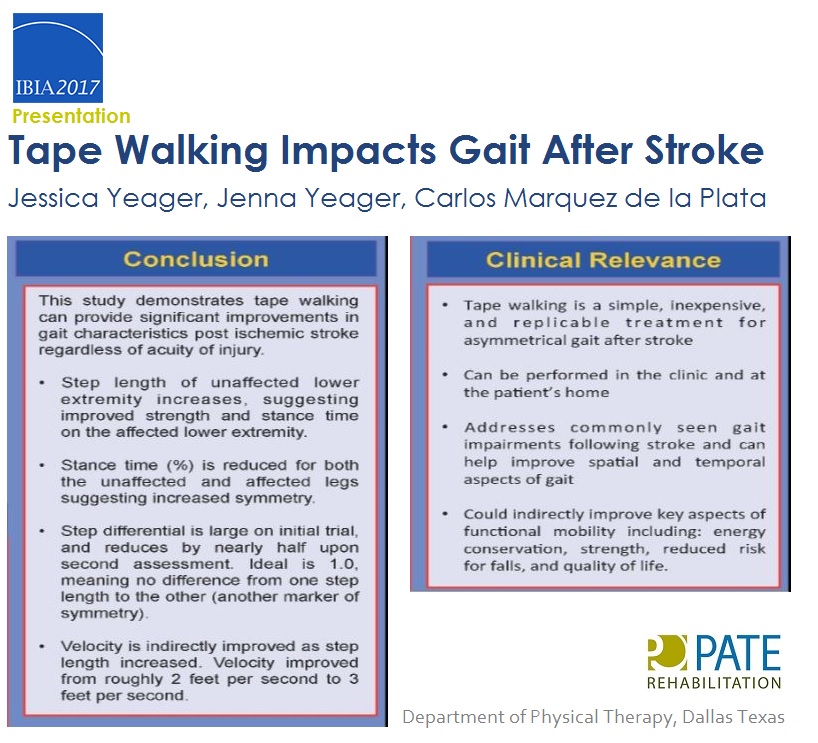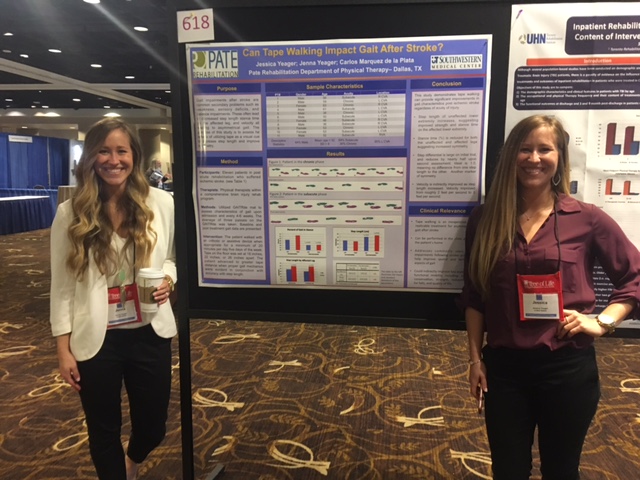Pate physical therapists Drs. Jenna and Jessica Yeager recently presented a tape gait training study at the International Brain Injury Association’s World Congress in New Orleans.
The Yeagers’ research demonstrates a simple yet effective intervention for post-stroke patients they adapted from treatments known to improve walking in patients with Parkinson’s disease.
Walking impairments are common after stroke (CVA) and include short, slow, and asymmetrical steps.
Physical therapy for gait problems is focused on improving balance and mechanics to increase safety and make walking less draining by improving energy efficiency.
The Yeagers wondered if gait treatments known to improve walking in patients with Parkinson’s disease might also help people post stroke.
Stroke and Gait Training
Ordinarily, physical therapists guide patients in gait training with verbal directions and feedback. The therapists visually monitor their patient’s progress.
The Parkinson’s tape gait training treatment places tape on the ground as an external visual cue and trains the patient to step from one piece of tape to another.
“Jenna and I had been taught to use external cues (auditory, visual, etc.) to assist with a variety of neurological diagnoses,” Jessica said. “The most common was to use the tape walking in Parkinson’s disease to assist with freezing as well. But we figured, we’re going to get people up and walking anyway, we want them to take longer steps, so why not just allow them to use a target to actually see if they are achieving the goal that I am telling them to do?”
Here’s how it works. Each piece of tape is a certain distance apart based on the norms of walking. Therapists help patients match their feet to the steps, and repeat the procedure throughout a therapy session. The distance between pieces of tape is increased systematically over the course of several weeks, depending on progress.

Pate’s intensive stroke therapy schedule of five days a week provided an ideal research setting for the Yeagers. “In a more traditional outpatient PT clinic, we would tell patients to perform this activity at home,” Jessica explained. “But since they get two hours of physical therapy a day five days a week, we could measure how quickly and effectively this intervention worked while ensuring that they were performing it well with a skilled therapist cuing them.”
Using a sample set of eleven patients in post-acute treatment who had experienced ischemic stroke, the Yeagers confirmed this simple treatment was indeed very effective.
The results demonstrate that patients who suffered a stroke take longer steps towards the “norm,” spend more time on their affected legs (required to improve strength), become more symmetrical side to side, and move at a faster pace than prior to the intervention. The replicable treatment can be used at clinics anywhere as well as the patient’s home.
Tape Gait Training Research Overview

TIPS Research Program

The Yeager sisters’ research is part of a new initiative led by Pate Rehabilitation research director and neuropsychologist Dr. Carlos Marquez de la Plata.
Its goal is to encourage Pate’s talented therapists to conduct their own research on creative treatment methods they have pioneered. The initiative is called TIPS or Therapeutic Intervention Protocol Sharing.
The program combines the scientific method and the clinical creativity Pate therapists are known for to develop and evaluate new interventions.
Upon discovering a successful intervention or technique, Pate therapists will present findings that can affect treatment in centers across the country.
The new research partnership will harness the insights and medical intuition of therapists and train them in research techniques.

